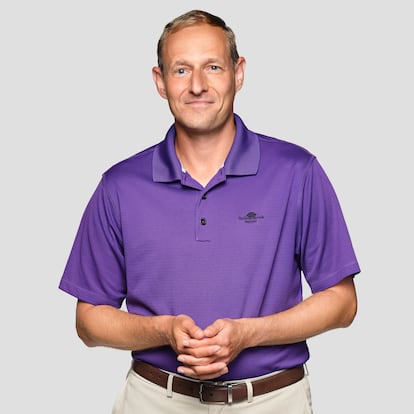Matthias Steffen, IBM physicist: ‘You can almost feel that we’re reaching quantum advantage’
The engineer behind the company’s Quantum Starling system hopes this error-tolerant supercomputer will lead to new compounds for treating diseases

Twenty-seven years ago, Matthias Steffen graduated from Emory University with a degree in physics. He later earned his doctorate in electrical engineering from Stanford. Since then, he has dedicated his life to the discipline that’s poised to explain matter and revolutionize the technological world.
Steffen joined IBM in 2006 and, for the past 15 years, has led the firm’s Quantum Processor Technologies organization. He’s responsible for the design, construction and testing of advanced, large-scale systems to realize quantum advantage and error-tolerant computing. Steffen recently announced Quantum Starling, the system poised to revolutionize this field as the world’s first large-scale quantum supercomputer.
Question. What does Quantum Starling entail?
Answer. In this field, we’re all [grappling with] how to deal with the errors that quantum computers are very prone to. We need to find correction codes to exponentially suppress error rates, with a slight increase in resources. Our team has discovered LDPC (low-density parity-check) codes. With this and new hardware technologies, we have a plan that will allow us to build Starling, which will have 200 logical qubits and be able to perform 100 million quantum operations on that system by 2029.
Q. Does this mean that we’ll soon be able to achieve quantum advantage? Will we be able to solve problems significantly faster – or more efficiently – than with any known classical supercomputer?
A. It will mark the beginning of large-scale problem solving. We’re fairly confident that we’ll be able to tackle interesting problems that require quantum advantage. We’re already able to solve the ground state of some complex molecules and compete with the best-known classical methods.
Q. Will a single Starling unit be 20,000 times more powerful than any existing quantum computer?
A. We’re getting the 20,000 number because [error-correcting] codes allow us to exponentially suppress errors using small groups of physical qubits, [hence] allowing us to execute 100 million quantum gates. That’s truly powerful. Reducing errors to an incredibly small [amount] allows us to execute 100 million operations with 200 logical qubits.
Q. Starling will be operational in 2029. Are any prototypes already being tested?
A. Yes, we’re building small prototype structures. This particular error-correcting code requires additional hardware development that – until earlier this year – didn’t really quite exist. We have multiple test devices where we’ve coupled one qubit to six others without observing any reduction in performance compared to our current processors. [This] also requires physically long [and high-quality] connections, without any performance degradation.
We’ve also improved the design methodology. The test structures we’ve built in the lab incorporate all the components that have been tested individually. IBM has a long history not only in the design, but also in the manufacturing of semiconductors. I’m really proud to be part of this team.
Q. Will Starling be accessible over the internet?
A. Our goal is to make all these devices and systems available to clients.
Q. Does the system involve artificial intelligence, or is it just quantum technology?
A. High-level quantum computing is a method to solve certain computational problems. It’s certainly not the magic bullet to solve all of the world’s problems, but [when it comes to] very specific ones, we know that there’s an exponential quantum advantage to using quantum computers. And this is the part that’s really exciting. [It also] fits very well with the rest of the company’s business model. IBM is a hybrid cloud and artificial intelligence company. The intention here is to provide computing solutions to clients in the form of hybrid cloud, AI and quantum solutions. Our intention is to seamlessly integrate all computing technologies.
Sign up for our weekly newsletter to get more English-language news coverage from EL PAÍS USA Edition
Tu suscripción se está usando en otro dispositivo
¿Quieres añadir otro usuario a tu suscripción?
Si continúas leyendo en este dispositivo, no se podrá leer en el otro.
FlechaTu suscripción se está usando en otro dispositivo y solo puedes acceder a EL PAÍS desde un dispositivo a la vez.
Si quieres compartir tu cuenta, cambia tu suscripción a la modalidad Premium, así podrás añadir otro usuario. Cada uno accederá con su propia cuenta de email, lo que os permitirá personalizar vuestra experiencia en EL PAÍS.
¿Tienes una suscripción de empresa? Accede aquí para contratar más cuentas.
En el caso de no saber quién está usando tu cuenta, te recomendamos cambiar tu contraseña aquí.
Si decides continuar compartiendo tu cuenta, este mensaje se mostrará en tu dispositivo y en el de la otra persona que está usando tu cuenta de forma indefinida, afectando a tu experiencia de lectura. Puedes consultar aquí los términos y condiciones de la suscripción digital.
More information
Archived In
Últimas noticias
Daytime, headphones, no booze involved: How a generation is saying ‘no’ to club parties
Millennia-old Yuracaré language resists extinction through 900 speakers and a new dictionary
Susan Boyle prepares a comeback just as Timothée Chalamet sings her praises
Trump suspends green card visa lottery after shooting at Brown University
Most viewed
- Christian Louboutin: ‘Young people don’t want to be like their parents. And if their parents wear sneakers, they’re going to look for something else’
- US sanctions against jailed cartel leader ‘El Marro’ highlight Mexico’s lack of control over its prisons
- Cartels in Mexico take a leap forward with narco-drones: ‘It is criminal groups that are leading the innovation race’
- Liset Menéndez de la Prida, neuroscientist: ‘It’s not normal to constantly seek pleasure; it’s important to be bored, to be calm’
- ‘El Limones’ and the growing union disguise of Mexican organized crime











































